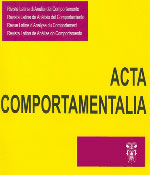Decreasing disruptive behavior through a “say-do” correspondence procedure
Main Article Content
Abstract
Behavioral interventions to reduce the level of disruptive behaviors have been based on the problems they caused to acquire adaptive repertoires. Reducing techniques mainly used were extinction, differential reinforcement, time out, response cost, and so on. In this work, an alternative way of a children freetime group activities. The experiment was implemented with ten children between 8-11 years old that showed a higth level of marginal indices (long term families unemployment, criminal and/or addictive behaviors among some members of their families, academic problems…) Five discruptive behaviors were elected (to stand up, to insult, to talk them, to shout and to unjustified complaint in player, to debate about some topic and to play). During baseline children showed a high and stabilized frequency of disruptive behaviors. Then, intervention was implemented. The alternative technique used was a say-do correspondence training (saying no- not doing- saying that he or she haven´t do). All the ten children answered that were not going to behave disruptively when they were asked, and some children were rewarded for fulfilling it. The high frequency of disruptive behaviors showed by the children in the baseline decreased sharply when the correspondence training was implemented. These results were maintained even when the tretment was removed (reducing cosequences and fading questions and answers). Resuts were analyzed by a within subjects analysis of variance, that confirmed the significant differences existing between baseline and intervention phases, and the absence of signiticant differences between intervention and maintainig phases. This paper added empirical evidence on the validity of correspondence training how a technique to use setting with the intervention are some important aspects to stand out. Additionally, we would say that these children have acquired some self-control behaviors that is an important repertoire to children with a high risk to develop criminal and/or addictive behaviors.
Article Details
Citas en Dimensions Service

<a rel="license" href="http://creativecommons.org/licenses/by-nc-sa/4.0/"><img alt="Licencia de Creative Commons" style="border-width:0" src="https://i.creativecommons.org/l/by-nc-sa/4.0/88x31.png" /></a><br />Este obra está bajo una <a rel="license" href="http://creativecommons.org/licenses/by-nc-sa/4.0/">licencia de Creative Commons Reconocimiento-NoComercial-CompartirIgual 4.0 Internacional</a>.
